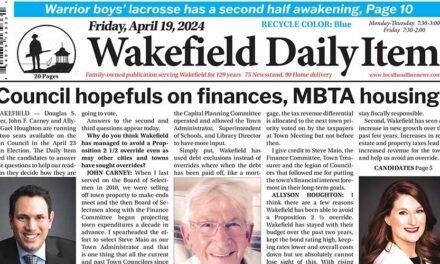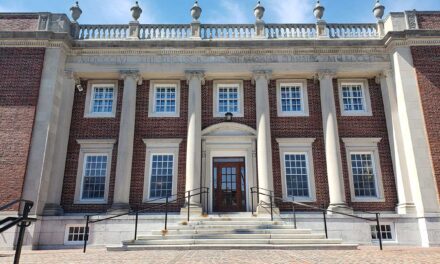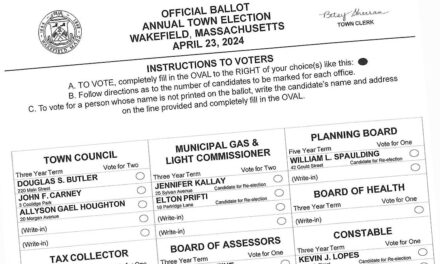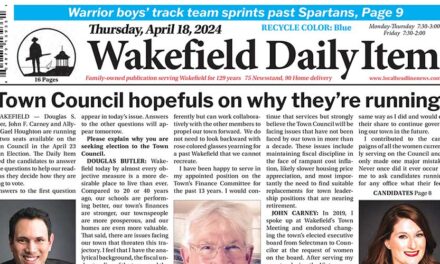Published in the September 13, 2019 edition.
By MARK SARDELLA
WAKEFIELD — This week, the Zoning Board of Appeals got its first look at a proposal for the next incarnation of the former American Mutual/Comverse building at 200-400 Quannapowitt Parkway.
Waterstone Properties Group purchased the property in January of 2018 for $15 million. They are seeking Special Permits and other relief from the ZBA related to their plans to lease the property for office space and testing laboratory use.
Waterstone Properties Group, Inc. is a privately-owned real estate development company with assets totaling over 7 million square feet of space in 14 states with an additional 3 million square feet under development. The firm specializes in the creation of retail centers, mixed‐use properties, residential projects, corporate headquarters, medical facilities and logistics/warehousing.
The property owners were represented at this week’s opening ZBA hearing by local attorney Brian McGrail as well as by Mark Vaughn, Waterstone’s general permitting attorney.
McGrail noted that the building had been used as office space since the 1950s until Digital Realty Trust (DRT) took over the property in 2010 for use as a data storage facility. He said that the proposed change in use will result in improvements to the property’s exterior and architecture to give it a more open and welcoming look. McGrail noted that the large generators that DRT had in a fenced-in portion of the parking lot are being removed.
McGrail told the ZBA that Waterstone has already received approval and an Order of Conditions from the Conservation Commission. The property sits on the northern shore of Lake Quannapowitt and borders marshland.
Waterstone is proposing to lease approximately one-third of the building as office space and two-thirds for research and laboratory use. Vaughn said that to date no specific tenants have been signed up to lease space in the building, but biopharmaceutical firms and other life science companies are looking to locate in this area. He said that Waterstone wants to have local approvals and permitting in place so that it can market the property.
ZBA member Ami Wall wanted to know if the laboratory space would be leased to firms that do testing on animals or that conduct research on infectious diseases.
Members of the Waterstone team, including one of the principal owners, Anton Melchionda, said that they did not anticipate such uses, and in any case, local state and federal regulations on those uses are very stringent. It was also suggested that the ZBA could impose conditions that would address some of those concerns.
McGrail noted that the site plan that was being presented for approval would also tend to limit the kinds of uses that could go into the building. He said that he would have to do more homework on the types of laboratory testing that are allowed in Massachusetts.
ZBA member Gregory McIntosh stressed that, whatever use ultimately goes in the building, there needs to be some sensitivity to any impacts on this area, which is very important to the town. Board member Joseph Pride observed that many research and development labs are 24-hour-a-day operations.
Chairman David Hatfield summarized the board’s concerns by pointing out that this was the first time in his memory that the ZBA has been asked to consider permitting a property without knowing specifically what the property will be used for.
There was some discussion of parking. McGrail said that a total of 645 spaces will be provided, which meets the parking requirements under the Zoning Bylaw.
Engineer Tim Williams discussed some of the plans for the 24-acre site. He talked about the removal of the generator pads and restoration of parking in that area. The patio on the Lake-facing side of the building will be restored.
Williams said that a storm water management plan will be implemented, including a bio-retention area in accordance with the Conservation Commission decision. Full landscaping will be incorporated into the site, Williams said. The entire site will be repaved and present flooding issues will be addressed.
Architect Derek Johnson discussed planned changes to the building exterior. He said that improvements would be aimed at bringing more life to the building. He said that the front of the building (facing the highway) will feature more glass, which will give it a more open look and provide more natural light inside the building.
ZBA member Chip Tarbell observed that the building currently looks tired and dirty. Johnson touched on some of the changes proposed to clean up and restore life to the building.
Giles Hamm of Vannesse and Associates briefly discussed traffic. He said that research and development use generally results in less traffic than office use. The ZBA indicated that it would like the Traffic Advisory Committee to take a look at the project.
ZBA member Jim McBain said that he would like to see some of the overgrown invasive species cleaned up along the property’s lake shore so that walkers have a view of the Lake.
When the hearing was opened up to public testimony, Scott Kelly of RJ Kelly at 100 Quannapowitt Parkway wanted assurances that his company’s parking lot wouldn’t be abused. He said that he would want to see proof that the parking ratio and employee count represented by Waterstone is accurate.
Jim Scott of Elm Street called the Waterstone plan “a good proposal,” adding that, “They will bring it back to the way it should be.”
Karen Faler of Lowell Street and the Friends of Lake Quannapowitt confirmed that Waterstone had reached out to FOLQ. She said that for the most part she was positive and optimistic about the plans for the site.
Bob McLaughlin congratulated Waterstone on saving the building. He also wanted assurances that snow would not be plowed into the Lake or the wetlands as has been the case in the past.
The hearing was continued to Sept. 25 when architecture, civil engineering and landscaping will be discussed in greater detail.




